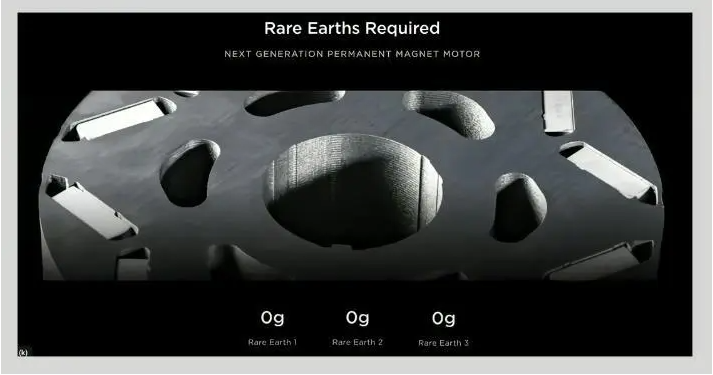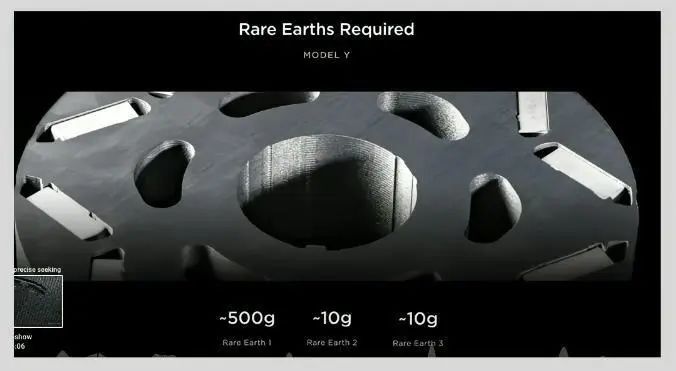
Due to supply chain and environmental issues, Tesla’s powertrain department is working hard to remove rare earth magnets from motors and is looking for alternative solutions.
Tesla has not yet invented a completely new magnet material, so it may make do with existing technology, most likely using cheap and easily manufactured ferrite.
By carefully positioning ferrite magnets and adjusting other aspects of motor design, many performance indicators of rare earth drive motors can be replicated. In this case, the weight of the motor only increases by about 30%, which may be a small difference compared to the overall weight of the car.
4. New magnet materials need to have the following three basic characteristics: 1) they need to have magnetism; 2) Continue to maintain magnetism in the presence of other magnetic fields; 3) Can withstand high temperatures.
According to Tencent Technology News, electric vehicle manufacturer Tesla has stated that rare earth elements will no longer be used in its car motors, which means that Tesla’s engineers will have to fully unleash their creativity in finding alternative solutions.
Last month, Elon Musk released the “Third Part of the Master Plan” at the Tesla Investor Day event. Among them, there is a small detail that has caused a sensation in the field of physics. Colin Campbell, a senior executive in Tesla’s powertrain department, announced that his team is removing rare earth magnets from motors due to supply chain issues and the significant negative impact of producing rare earth magnets.
To achieve this goal, Campbell presented two slides involving three mysterious materials cleverly labeled as rare earth 1, rare earth 2, and rare earth 3. The first slide represents Tesla’s current situation, where the amount of rare earths used by the company in each vehicle ranges from half a kilogram to 10 grams. On the second slide, the usage of all rare earth elements has been reduced to zero.
For magnetologists who study the magical power generated by electronic motion in certain materials, the identity of rare earth 1 is easily recognizable, which is neodymium. When added to common elements such as iron and boron, this metal can help create a strong, always on magnetic field. But few materials have this quality, and even fewer rare earth elements generate magnetic fields that can move Tesla cars weighing over 2000 kilograms, as well as many other things from industrial robots to fighter jets. If Tesla plans to remove neodymium and other rare earth elements from the motor, which magnet will it use instead?


For physicists, one thing is certain: Tesla did not invent a completely new type of magnetic material. Andy Blackburn, Executive Vice President of Strategy at NIron Magnets, said, “In over 100 years, we may only have a few opportunities to acquire new business magnets.” NIron Magnets is one of the few startups trying to seize the next opportunity.
Blackburn and others believe it is more likely that Tesla has decided to make do with a much less powerful magnet. Among many possibilities, the most obvious candidate is ferrite: a ceramic composed of iron and oxygen, mixed with a small amount of metal such as strontium. It is both cheap and easy to manufacture, and since the 1950s, refrigerator doors around the world have been manufactured in this way.
But in terms of volume, the magnetism of ferrite is only one tenth that of neodymium magnets, which raises new questions. Tesla CEO Elon Musk has always been known for being uncompromising, but if Tesla is to shift to ferrite, it seems that some concessions must be made.
It is easy to believe that batteries are the power of electric vehicles, but in reality, it is electromagnetic driving that drives electric vehicles. It is no coincidence that both Tesla Company and the magnetic unit “Tesla” are named after the same person. When electrons flow through the coils in a motor, they generate an electromagnetic field that drives the opposite magnetic force, causing the motor’s shaft to rotate with the wheels.
For the rear wheels of Tesla cars, these forces are provided by motors with permanent magnets, a strange material with a stable magnetic field and no current input, thanks to the clever spin of electrons around atoms. Tesla only started adding these magnets to cars about five years ago, in order to extend range and increase torque without upgrading the battery. Prior to this, the company used induction motors manufactured around electromagnets, which generate magnetism by consuming electricity. Those models equipped with front motors are still using this mode.
Tesla’s move to abandon rare earths and magnets seems a bit strange. Car companies are often obsessed with efficiency, especially in the case of electric vehicles, where they are still trying to persuade drivers to overcome their fear of range. But as car manufacturers begin to expand the production scale of electric vehicles, many projects that were previously considered too inefficient are resurfacing.
This has prompted car manufacturers, including Tesla, to produce more cars using lithium iron phosphate (LFP) batteries. Compared to batteries containing elements such as cobalt and nickel, these models often have shorter range. This is an older technology with greater weight and lower storage capacity. At present, the Model 3 powered by low-speed power has a range of 272 miles (approximately 438 kilometers), while the remote Model S equipped with more advanced batteries can reach 400 miles (640 kilometers). However, the use of lithium iron phosphate battery may be a more sensible business choice, because it avoids the use of more expensive and even politically risky materials.
However, Tesla is unlikely to simply replace magnets with something worse, such as ferrite, without making any other changes. University of Uppsala physicist Alaina Vishna said, “You will carry a huge magnet in your car. Fortunately, electric motors are quite complex machines with many other components that can theoretically be rearranged to reduce the impact of using weaker magnets.
In computer models, material company Proterial recently determined that many performance indicators of rare earth drive motors can be replicated by carefully positioning ferrite magnets and adjusting other aspects of motor design. In this case, the weight of the motor only increases by about 30%, which may be a small difference compared to the overall weight of the car.
Despite these headaches, car companies still have many reasons to abandon rare earth elements, provided they can do so. The value of the entire rare earth market is similar to that of the egg market in the United States, and theoretically, rare earth elements can be mined, processed, and converted into magnets worldwide, but in reality, these processes present many challenges.
Mineral analyst and popular rare earth observation blogger Thomas Krumer said, “This is a $10 billion industry, but the value of products created each year ranges from $2 trillion to $3 trillion, which is a huge lever. The same goes for cars. Even if they only contain a few kilograms of this substance, removing them means that cars can no longer run unless you are willing to redesign the entire engine
The United States and Europe are trying to diversify this supply chain. The California rare earth mines, which were closed in the early 21st century, have recently reopened and currently supply 15% of the world’s rare earth resources. In the United States, government agencies (especially the Department of Defense) need to provide powerful magnets for equipment such as airplanes and satellites, and they are enthusiastic about investing in supply chains domestically and in regions such as Japan and Europe. But considering cost, required technology, and environmental issues, this is a slow process that can last for several years or even decades.
Post time: May-11-2023